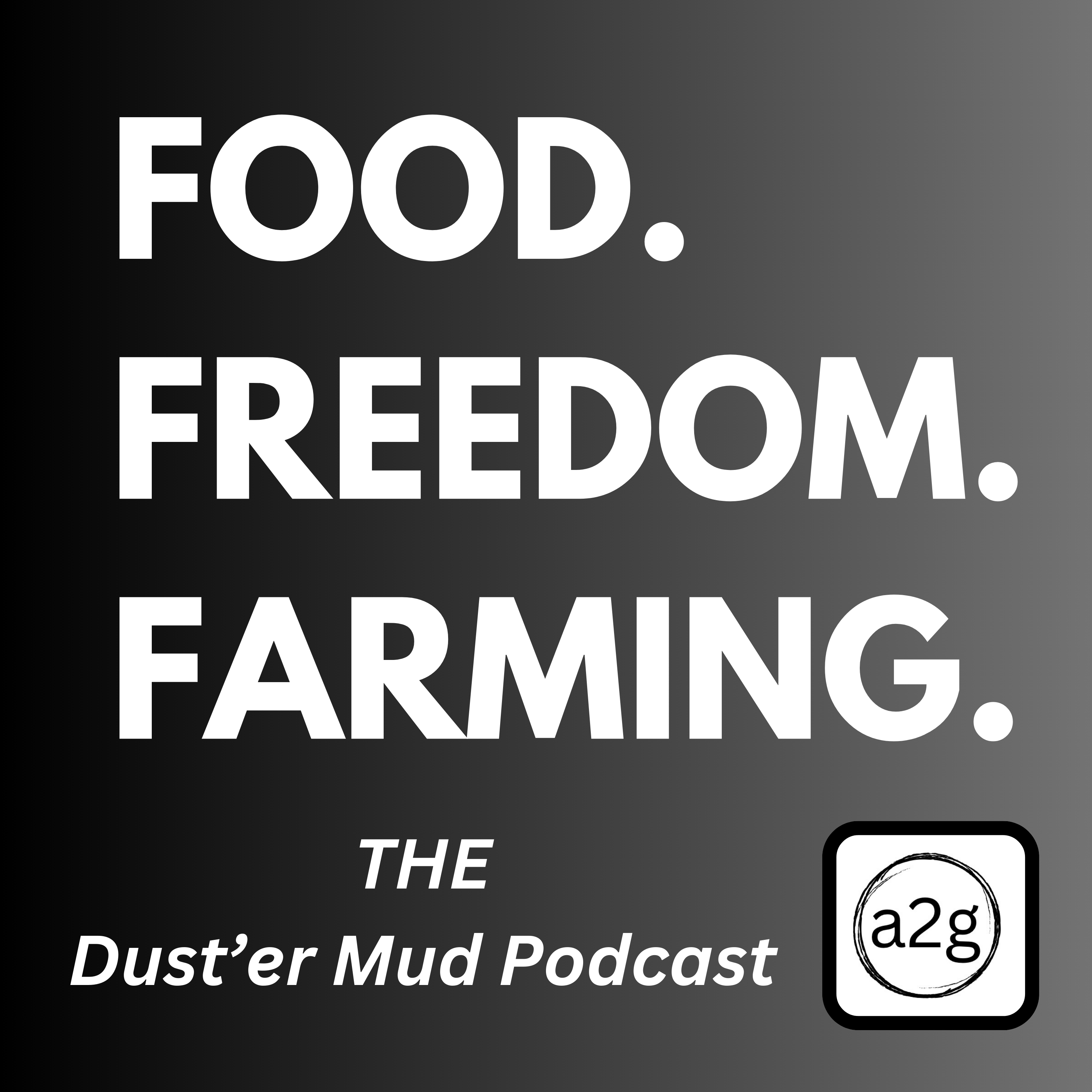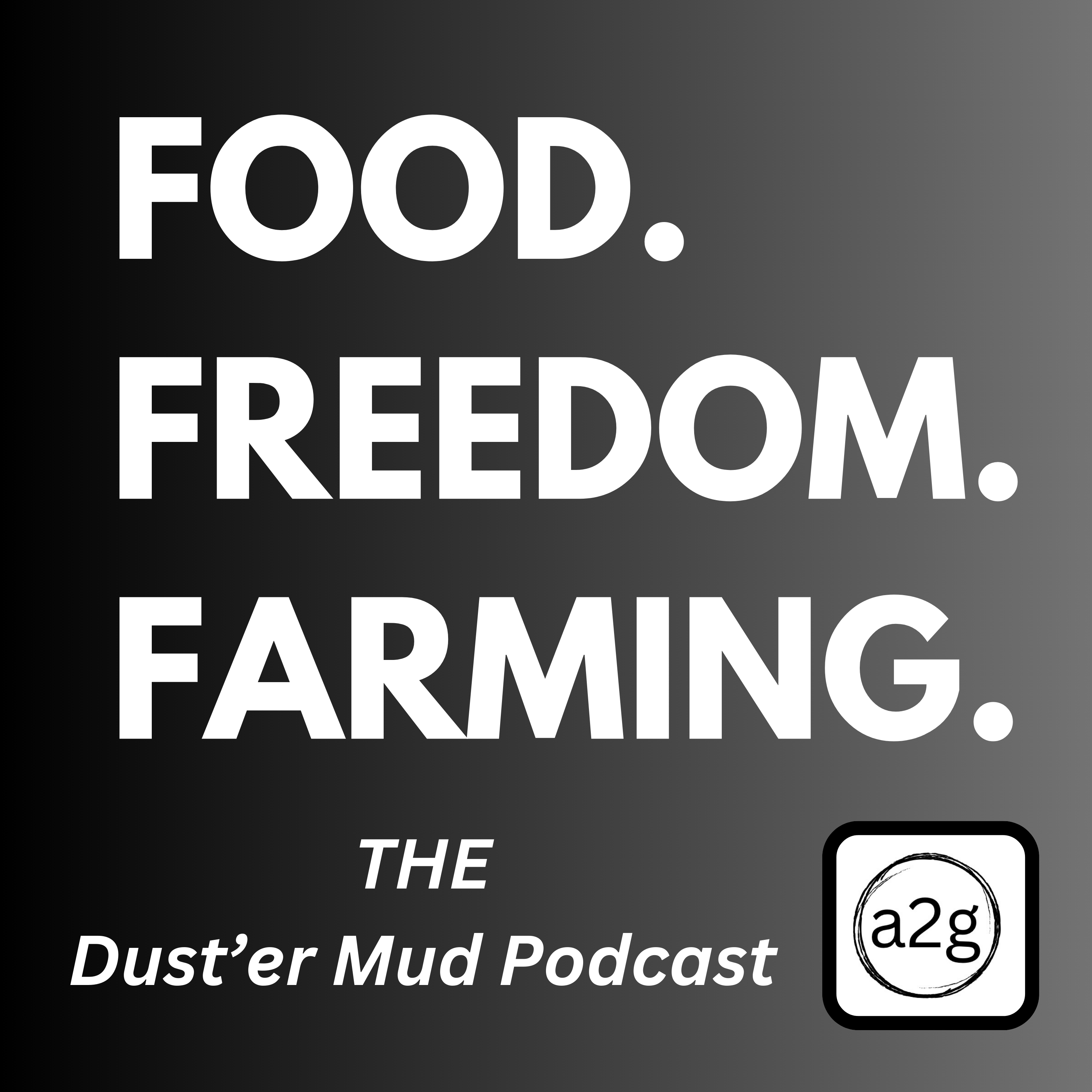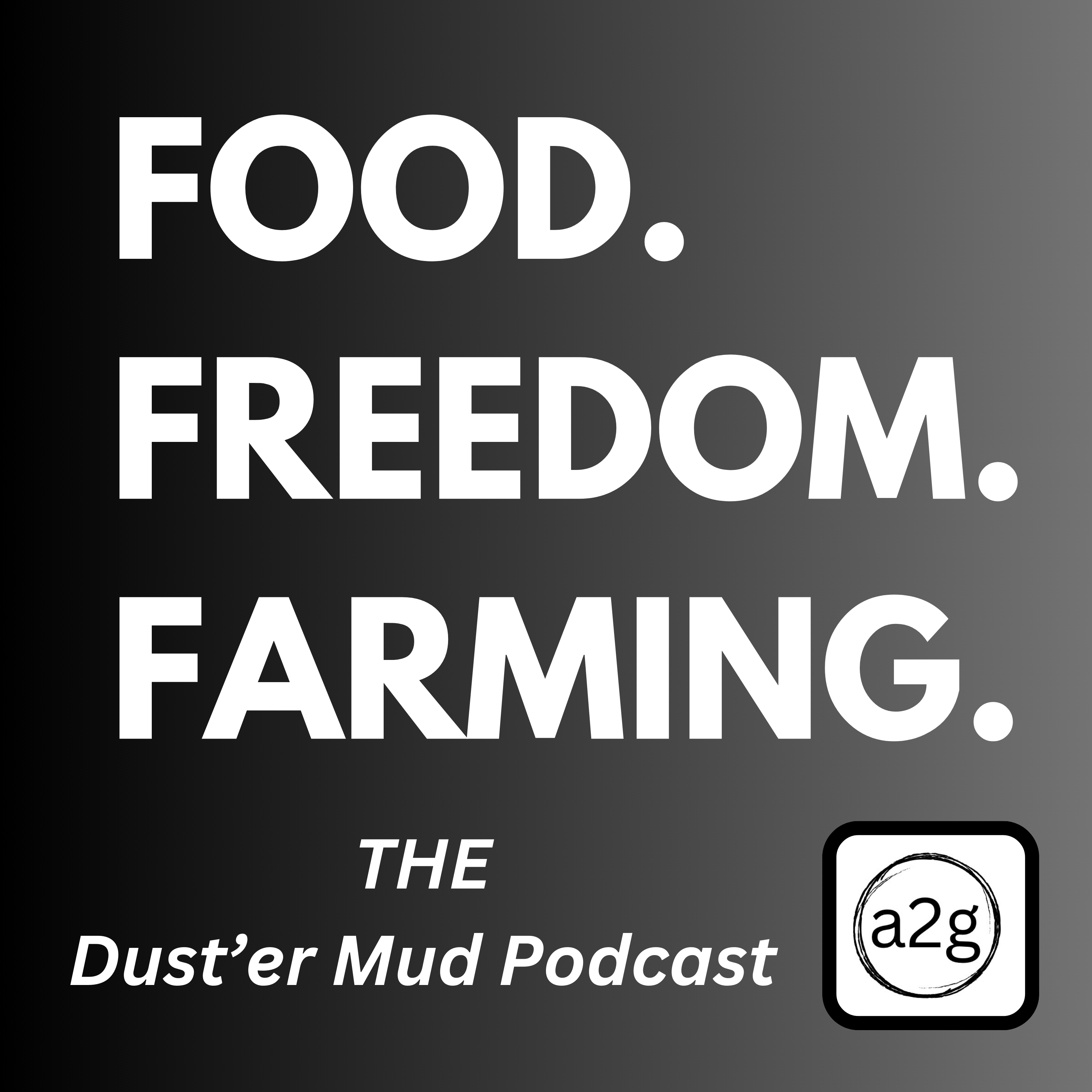Episode Transcript
[00:00:00] Speaker A: Your journey with Keto may sometimes be a little bit lacking in the actual fat department. Today, we're going to cover five of the top fats to boost your keto diet. In 2018, Keto was hot, hot, hot, super trending. In 2024. It still works. Welcome to the Duster Mud podcast.
[00:00:22] Speaker B: I'm rich.
[00:00:22] Speaker A: And I'm Shelly.
[00:00:24] Speaker B: After 25 years in the United States Air Force, we retired to the Ozarks of Missouri, started a regenerative farm and a podcast.
[00:00:33] Speaker A: And in this podcast, we cover all things food freedom and farming. And today, we're gonna tackle the fats of a ketogenic lifestyle.
[00:00:42] Speaker B: In 2019, we started a ketogenic journey. I was diagnosed with Crohn's disease in 2013 and was fussing a bit with my diet between those times. And so in 2019, I decided to give this crazy diet called the ketogenic diet, a try. And one of the first things we had to learn was it's just a completely different way of thinking about food. And I think the biggest. The biggest mental shift for us was that your caloric intake needs to approach 70% from fat. And that is just so different than what we learned growing up in the 1980s, where fats became really bad and everything transitions to a low fat this and a low fat that, and all of the. The flavor that was missing from the. From removing the fat was made up with sugars. And so we really learned. We grew up learning how to eat, being a high carbohydrate, low fat diet. So it was a. A big change for us.
[00:01:56] Speaker A: So the big change, it actually is a really easy diet. You add fat, but since it's such a paradigm shift, like what you're talking about, it becomes difficult just in our mindset. So if we can wrap our brains around the fact that this is really good for us, it's going to give us energy, and it's going to make us more healthy, then it's really not hard to do. Let's get into some of those fats.
[00:02:21] Speaker B: One of the things that we learned as we were starting this ketogenic diet was really to focus on the day as a whole and not each individual meal as a standalone thing. So in the day as a whole, we tried to get 70% of our calories from fat, 20% or so of our calories from protein, and then the remaining 10% from carbohydrates.
[00:02:51] Speaker A: One of the ways that we helped us track that was we used the Carb manager app, which we have talked about before in previous podcasts. But I wanted to bring it up again real quick. Is that is a great tool to track your macros as you're, as you go about your day.
[00:03:06] Speaker B: Yeah. And it does it as a daily total. Also, it makes a wrap around a ring. And as you fill in your daily intake, it then fills in the ring and you try to fill up that ring as far as your fats are concerned.
[00:03:20] Speaker A: Right. So we mentioned that you want to hit 70% of your calories in fat and 20% in your proteins, and then the rest of it in a few carbohydrates. One of the most perfect foods that is out there is something that we're really fond of, and we grow a whole bunch of them here on this farm. And that's eggs. The incredible edible egg really is just that incredible whenever you're a eating a ketogenic diet, because the numbers on an egg are almost perfect with. What are the percentages on that?
[00:03:56] Speaker B: Well, your total calories are somewhere depending on the size of the egg, between 70 and 80 calories. And of those calories, right, at 65% of them come from fat and 35% of them come from protein, they're basically negligible carbs in an egg. So you're almost at that 70 30 split that you're looking for for a ketogenic diet.
[00:04:18] Speaker A: So the number one thing that you can do right off the bat is eat more eggs in your diet. And we like to do that.
[00:04:26] Speaker B: Yeah.
[00:04:27] Speaker A: Cause we have a lot of them, a ridiculous amount of them right now.
That's okay, y'all. I mean, a lot. Okay. So let's carry on. Okay.
[00:04:39] Speaker B: Top five fats to add into your diet to get you to those ketogenic numbers. The first one, avocados. Avocado oil.
[00:04:49] Speaker A: Avocados are awesome because the avocado itself is rich in vitamins. It has lots of fiber, it has very few carbohydrates, and a whole bunch of nutrition. And high in fat.
[00:05:04] Speaker B: Yeah. And then the avocado oil we use that we do not use seed oils, y'all know, corns and canolas and peanuts and all of the other seed oils, those are out of our diet completely.
[00:05:15] Speaker A: I recommend that you get them out of your diet, too.
[00:05:18] Speaker B: So highly inflammatory in place of that. That's normally where we use avocado oil. It has a high smoke point, so it's good to cook with. And it also really doesn't have much of a flavor at all. So in those things where you would want to add oil that you don't really want the flavor from the oil. That's when we use avocado oil.
[00:05:41] Speaker A: The smoke point on avocado oil is 520 degrees, so you can get it nice and hot. You can do it. If you're sauteing something or really want to brown something, that's a perfect oil for doing that.
[00:05:54] Speaker B: So you bring up smoke point, and each oil has a temperature at which it literally starts to smoke. And at that temperature, the oil starts to break down, it breaks apart, and it loses a lot of its nutritional value, and it also starts gaining some things that aren't really good for you. So we do pay attention to the smoke point of the different oils that we're cooking with, and we change. If we want a specific oil, we just adjust the way that we're cooking for that oil. Or if we want to cook at a specific temperature, then similarly, we will just pick an oil that goes with that temperature.
[00:06:33] Speaker A: Right. Thank you for that clarification.
[00:06:36] Speaker B: You're welcome.
[00:06:36] Speaker A: Coming in number two is coconut oil and MCT oil. These are two different oils, actually. I kind of thought they were the same. Turns out they're not. We learn something new every day. Coconut oil is just that. It is coconut oil. While coconut oil does have medium chain triglycerides in it, it isn't solely made up of that. If you want something that has a concentrated amount of mcts, get actual McT oil. The best quality that you can find.
[00:07:08] Speaker B: To make MCT oil. They heat up either coconut oil or a palm kernel oil. They heat it and cool it, and they separate out the medium chain triglycerides, so it becomes a different oil. McT oil will stay liquid at room temperature, where most of the time, in most of our rooms, coconut oil will become a solid. In warmer households, it may stay a liquid, but MCT oil will stay liquid.
[00:07:35] Speaker A: One of the key things that MCT oil can do for us whenever we're on a ketogenic journey is provide an enormous amount of energy. And the reason that it does that is because it hits your stomach and goes straight to your liver. And then what?
[00:07:51] Speaker B: Your liver then turns quickly. MCT oil quickly converts it into ketones.
[00:07:57] Speaker A: Exactly. And ketones are where we're getting our energy from when we're on a ketogenic diet.
[00:08:02] Speaker B: That's right. Shelly mentioned a high quality MCT oil. I will tell you that I don't know if it's Crohn's disease or just my stomach is a little bit sensitive, but low quality MCT oil does not do well with my stomach. I can only have have it in very small amounts. Like if we do, say, one tablespoon in a bowl of yogurt or something, I will be fine. If that get goes to two tablespoons, I will not be fine.
[00:08:29] Speaker A: Yeah. So make sure that whenever you do buy it, if you're getting a cheap, cheap brand of MCT oil at somewhere like Walmart or Costco or something, just know that if you try to add too much, it can give you digestive discomfort, very discomfort.
So beware of that. If you get a really high quality, though, the ones we've, when we've gotten, say, the bulletproof brand, you can eat whatever amount pretty much that you want and it doesn't affect you.
[00:08:59] Speaker B: That one is called brain octane, the bulletproof brand, and it does seem to do better with much better.
[00:09:05] Speaker A: It does much better.
[00:09:06] Speaker B: Yeah. Nuts and seeds are another great addition for fats in your diet. I have to be careful with specifically almonds. My body doesn't like them too well. But macadamia nuts are great. Flaxseeds are good. Pecans are also very good. Pecans in macadamia nuts specifically are good because their carb count is low, but, but their fats are high. You do have to be careful with some nuts, though, because they do have more carbs than others. So some, like cashews, have, have quite a few. So not that you can't eat them. They certainly have a lot of fats in them as well. Just sort of be careful on your serving size if you're really trying to limit the carbs.
[00:09:49] Speaker A: The fourth kind of fat we want to cover is what I consider probably the number one fat, and that's butter and its best friend, ghee butter. Having a lower smoke point, you're going to want to use that in things that you're going to slow simmer with at a smoke point of 350 degrees. And ghee, on the other hand, since the milk particles have been removed from the butter and you really just have the shelf stable fat remaining, it has a higher smoke point of 485 degrees, so you can just saute away with the ghee.
[00:10:28] Speaker B: Yeah.
[00:10:29] Speaker A: Big fans add such richness to your food, and it's very, very satisfying.
[00:10:35] Speaker B: Yeah, we used it a lot when we were starting out in our coffees in the morning. Ghee specifically. And, boy, it adds just a really, I don't know, nutty, almost just really nice flavor.
[00:10:47] Speaker A: Yeah. Two tablespoons or one tablespoon of ghee in your coffee with a little whiskey blender. Not whiskey like whisk. Don't put whiskey in your coffee in the mornings. That's bad.
A whisk little blender in your coffee and whip it up and it is delicious. Yeah. Don't put whiskey in your coffee.
You're gonna leave that in there, aren't you? Probably go ahead and do olive oil. Some olive oil.
[00:11:25] Speaker B: The final fat that we'll talk about is olive oil. And believe it or not, there's a difference between extra virgin olive oil and regular olive oil. The extra virgin has a considerably lower smoke point. So the extra virgin olive oil is 375, where regular olive oil is up at 465. So they both will add flavor to the dish that you're eating or cooking with. We use olive oil a lot just to pour over the top of things like oil and vinegar on a salad.
[00:11:59] Speaker A: Yeah. So we did a video a couple of weeks ago and it was about creating, taking a chicken breast type meal with some salad. It was chicken and some greens. And we turned that little meal into a, quote, keto meal and tried to make it, well, he tried to make it percent caloric, percentage keto. And he handed me like a half a cup of olive oil. And that was what was going to make that thing keto. Obviously, I did not choke down the half a cup of olive oil, even for the video, because it's disgusting. But the point was made that olive oil, just drizzling it over your, all of your vegetables, any of your meats, anything like that, just adding little bits here and there, really get the fats up in your diet.
That was disgusting.
[00:12:56] Speaker B: Olive oil itself is good.
[00:12:57] Speaker A: Olive oil is very good in limited amounts.
[00:13:04] Speaker B: Maybe not with a straw.
[00:13:06] Speaker A: Not with a straw.
[00:13:07] Speaker B: So we talked about a bunch of the different fats in order to incorporate them into your diet.
We mentioned a couple of videos ago, you can really do lots of different things with them. Nuts you can just throw on as a snack, you can throw them in as an addition to salads or things like that. And then the oils, really, probably the best way is just to cook with them, right?
[00:13:33] Speaker A: Cook with them, use them for flavor, have so much nutritional value in each of those types of oils and just add it.
Since we started talking about this again, I, every time I make things, I'm putting extra. If I used to tell the kids, when you're seasoning something, add however much you think and then add some more because you're probably under seasoning for on safety side, whenever you're cooking with these oils and you're trying to be ketogenic, add as much as you think you need and then add some more, and then you're probably getting to that keto point.
[00:14:14] Speaker B: Another thing that we find is, you know, we spent so many years, especially after things like ground beef or ground pork or sausage, you would drain the fat. You make sure you drain the fat.
[00:14:28] Speaker A: Oh, my goodness.
[00:14:30] Speaker B: On a ketogenic diet or with a ketogenic lifestyle, it's the opposite of that. Don't drain the fat. Find a way to incorporate that fat into the meal. Whether it's adding something in, like, a little bit of egg that will emulsify with the fat and turn it into more of a gravy, like do something to, so that you hang on to that fat and like Shelly says, probably even add a little bit more.
[00:14:55] Speaker A: One of the neat things about a ketogenic lifestyle is it's actually fairly budget friendly, in my opinion, because you can buy a lot of calories in a bottle, and that is what you're doing. You're trying to get 70% of your calories as fat. And whenever you do that and you buy a big old bottle of oil or wherever you get your fat from, that is a lot of calories and a lot of energy in that one bottle for $10 or $20, and it's going to last you quite a long time versus having to buy other types of packaged foods that are less calorically favorable. Yeah.
So it also is budget. It can be budget friendly. Yeah.
[00:15:44] Speaker B: True.
[00:15:45] Speaker A: This way of eating may seem and may feel very unconventional or maybe even a little bit of go against the grain, but we encourage you to stay on your course and on your journey because you're. You're deciding for you what's best for you.
[00:15:58] Speaker B: Yeah. And it is different. Like, we, we absolutely understand that. And it's a complete paradigm shift in your thinking of what is healthy and what is not healthy. And especially when you look at the amount of fat that it takes in a day to get you to 70% of your calories as fat. The way we grew up, that doesn't seem healthy. So it really does take a mindset shift in order to really embrace this lifestyle.
[00:16:26] Speaker A: So stay strong, add the fat, and remember to make that meal awesome. And add some sauce. Sauce.


